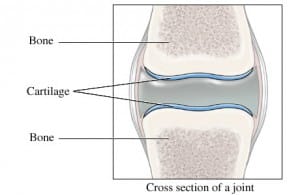KNEE OSTEOARTHRITIS
The knee consist of three separate joint articulations (superior tibiofibular, patellofemoral and tibiofemoral joints) and any one of these can be prone to wear-and-tear (osteoarthritis).

So what actually happens? The early stages of the degeneration process are thought to occur when an abnormal force or the cumulative effects of a sustained faulty posture, or overuse, leads to a sequence of events taking place within the cartilage of a joint, ultimately leading to exposure of some of the underlying bone. The resultant cartilaginous debris causes irritation within the joint and bone spurs (osteophytes) gradually form. The knee is particularly prone to such changes as it’s a weight-bearing joint.
The diagram above gives a good outline of a synovial type joint, but it does not show the pad of fibro-cartilage (meniscus) which sits between the shin (tibia) and thigh (femur). It’s also quite different from the patella femoral joint, which is outlined in the patella pain syndrome section.
In very crude terms, the tibio-femoral joint deals with large compressive loads, which is partly why the meniscus is so essential, and the patella femoral joint is more exposed to translational (friction) type forces as it glides up and down the front of the knee, hence why the thickest chondral cartilage is found under the patella (knee cap). It’s important to appreciate that both joints deal with high load forces in both compression and translation (friction) in almost all movements, but also that certain tasks and actions can have a biased on certain joints. For example, a squash player who is performing very powerful and sudden movements will require his knees to cope with very high compressive loads, which all joints must manage, and a carpet layer or plumber will spend long periods kneeling down, creating a lot of compression and friction when moving.
The tibio-fibular joint, which connects the two long bones on the outside of the lower leg, is often forgotten. It’s not as obvious or mobile as the other joints that make up the knee. However, it is still very much a weight-bearing joint which can be damaged by over use and one-off trauma, such as motorbike accidents. This joint is of particular interest, because it has many important structures, such as the anterior tibial nerve, common peroneal nerve and the anterior tibial artery in close proximity which can be affected by osteophytes (bony outgrowths) associated with wear-and-tear of this joint. This may cause a variety of symptoms which originate from the joint, but pain and symptoms are experienced lower down the leg and foot. Bodymotion chiropractors and sports rehabber are trained to assess this joint and any associated symptoms.
DIAGNOSIS
At Bodymotion, our Chiropractors take a thorough history, which often gives many clues as to how or why a joint has become irritated. This may relate to activities, previous injuries, infections, direct trauma, family history, etc. The patient is then given a thorough postural assessment, which will often show signs that an individual may have some signs of osteoarthritic changes (wear-and-tear). Commonly in the knee, this is often observed as bony enlargement in the medial part over the joint line (where the thigh bone meets the shin bone). There may also be malignment of the knee (knocked-knee or bowed-leg appearance) and an inability to fully straighten the knee. These changes are gradual and the human body is incredible at adapting, so many patients are unaware of these alterations until they are pointed out to them.
A suspected diagnosis of osteoarthritis can be confirmed via x-ray. Special views may be requested by our chiropractors, depending on which joint in the knee is involved. There may also be a request for some blood tests to rule out other forms of arthritis, such rheumatoid arthritis. As primary care practitioners, chiropractors are trained to know when referral for such tests are appropriate.
TREATMENT
Although these degenerative changes cannot be reversed, chiropractic can help to improve joint range of movement, reducing pain (Beyerman et al, 2006). Furthermore, by improving joint function, relieving muscle stiffness and improving posture, chiropractic may reduce the rate of further degenerative changes.
(The list of conditions given above and subsequent explanations are intended as a general guide and should not be considered a replacement for a full medical examination. Furthermore, we do not purport to treat all the conditions listed. Should you wish to discuss any of these conditions with our chiropractors, please do not hesitate to phone the clinic on 020 7374 2272 or email enquiries@body-motion.co.uk).
Our team of chiropractors and massage therapists are on hand to answer any questions you may have, so get in touch today via enquiries@body-motion.co.uk or on +44 (0)20 7374 2272.
